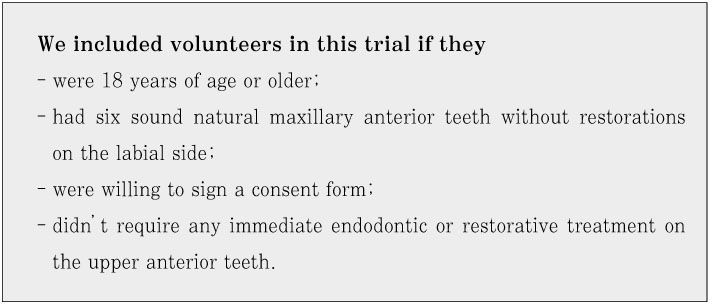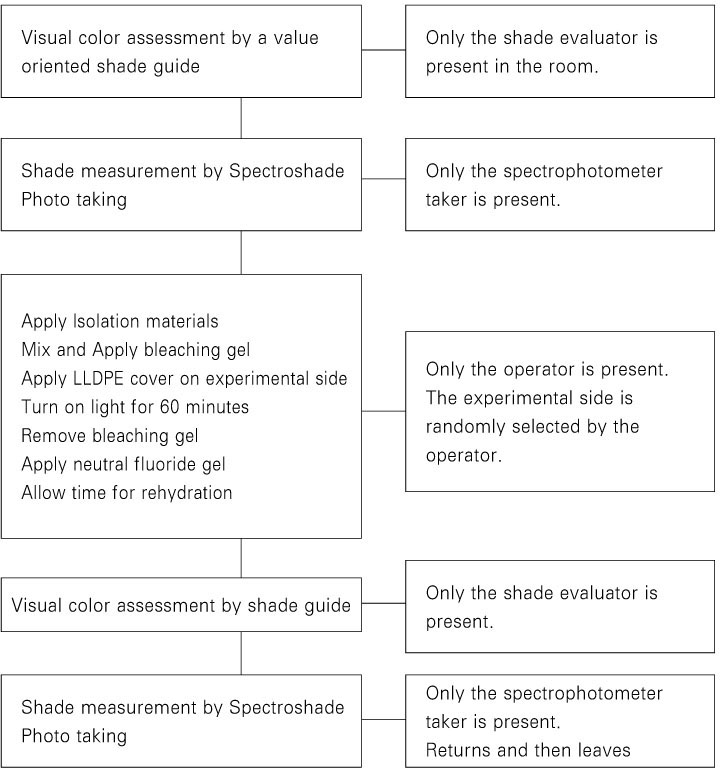J Korean Acad Conserv Dent.
2008 Sep;33(5):463-471. 10.5395/JKACD.2008.33.5.463.
The effectiveness of sealing technique on in-office bleaching
- Affiliations
-
- 1Department of Conservative Dentistry, College of Dentistry, Yonsei University Youngdong Severance Hospital, Seoul, Korea. pjw@yuhs.ac
- 2Michigan Dental Clinic, Seoul, Korea.
- KMID: 1986785
- DOI: http://doi.org/10.5395/JKACD.2008.33.5.463
Abstract
- This study investigated the clinical effectiveness and safety of sealed bleaching compared to conventional in-office bleaching using a randomized clinical trial of split arch design. Ten participants received a chairside bleaching treatment on the upper anterior teeth, and each side was randomly designated as sealed or control side. A mixture of Brite powder (PacDent, Walnut, USA), 3% hydrogen peroxide and carbamide peroxide (KoolWhite, PacDent, Walnut, USA) were used as bleaching agent. The control side was unwrapped and the experimental side was covered with a linear low density polyethylene (LLDPE) wrap for sealed bleaching. The bleaching gel was light activated for 1 hour. The tooth shades were evaluated before treatment, after treatment, and at one week check up by means of a visual shade (VS) assessment using a value oriented shade guide and a computer assisted shade assessment using a spectrophotometer (SP). The data were analyzed by paired t-test. In the control and sealed groups, the visual shade scores after bleaching treatment and at check up showed statistically significant difference from the preoperative shade scores (p < .05). The shade scores of the sealed group were significantly lighter than the control immediately after bleaching and at the check-up appointment (p < 0.05). Compared to prebleaching status, the DeltaE values at post-bleaching condition were 4.35 +/- 1.38 and 5.08 +/- 1.34 for the control and sealed groups, respectively. The DeltaE values at check up were 3.73 +/- 1.95 and 4.38 +/- 2.08 for the control and sealed groups. DeltaE values were greater for the sealed group both after bleaching (p < .05) and at check up (p < .05). In conclusion, both DeltaE and shade score changes were greater for the sealed bleaching group than the conventional bleaching group, effectively demonstrating the improvement of effectiveness through sealing.
MeSH Terms
Figure
Reference
-
1. Dunn JR. Dentist-prescribed home bleaching: current status. Compend Contin Educ Dent. 1998. 19:760–764.2. Papathanasiou A, Kastali S, Perry RD, Kugel G. Clinical evaluation of a 35% hydrogen peroxide in-office whitening system. Compend Contin Educ Dent. 2002. 23:335–338. 340343–344. passim; quiz 348.3. Goldstein RE, Garber DA. Complete Dental Bleaching. 1995. Carol Stream, IL, USA: Quintessence Publishing Co., Inc.;32.4. Miara P. An innovative chairside bleaching protocol for treating stained dentition: initial results. Pract Periodontics Aesthet Dent. 2000. 12:669–676. quiz 678.5. Sulieman M. An overview of bleaching techniques: 3. In-surgery or power bleaching. Dent Update. 2005. 32:101–104. 107–108.
Article6. Sulieman M. An overview of bleaching techniques: I. History, chemistry, safety and legal aspects. Dent Update. 2004. 31:608–610. 612–614. 6167. Kwon SR, Ko SH. Color Atlas of Tooth Whitening. 2006. Seoul, Korea: Daehan Narae Publishing, Inc.;108–110.8. Chu SJ, Devigus A, Mieleszko A. Fundamentals of color : shade matching and communication in esthetic dentistry. 2004. Carol Stream, IL: Quintessence Pub. Co..9. Zekonis R, Matis BA, Cochran MA, Al Shetri SE, Eckert GJ, Carlson TJ. Clinical evaluation of in-office and at-home bleaching treatments. Oper Dent. 2003. 28:114–121.10. Luk K, Tam L, Hubert M. Effect of light energy on peroxide tooth bleaching. J Am Dent Assoc. 2004. 135:194–201. quiz 228-9.
Article11. Greenwall L. Bleaching techniques in restorative dentistry. 2001. London, UK: Martin Dunitz, Ltd.;134–135. 244–247. 255–258.12. Haywood VB. Frequently asked questions about bleaching. Compend Contin Educ Dent. 2003. 24:324–338.13. Hein DK, Ploeger BJ, Hartup JK, Wagstaff RS, Palmer TM, Hansen LD. In-office vital tooth bleaching--what do lights add? Compend Contin Educ Dent. 2003. 24:340–352.14. Miller L. Organizing color in dentistry. J Am Dent Assoc. 1987. Spec No:26E–40E.
Article15. Chu SJ. Use of a reflectance spectrophotometer in evaluating shade change resulting from tooth-whitening products. J Esthet Restor Dent. 2003. 15:Suppl 1. S42–S48.
Article16. Paul S, Peter A, Pietrobon N, Hammerle CH. Visual and spectrophotometric shade analysis of human teeth. J Dent Res. 2002. 81:578–582.
Article17. Deliperi S, Bardwell DN, Papathanasiou A. Clinical evaluation of a combined in-office and take-home bleaching system. J Am Dent Assoc. 2004. 135:628–634.
Article
- Full Text Links
- Actions
-
Cited
- CITED
-
- Close
- Share
- Similar articles
-
- Effect of post-bleaching time intervals on resin in dentin bonding strength
- A clinical evaluation of safety of an office bleaching gel containing 30% hydrogen peroxide
- Can carbamide peroxide be as effective as hydrogen peroxide for in-office tooth bleaching and cause less sensitivity? A systematic review
- Does the time interval after bleaching influence the adhesion of orthodontic brackets?
- Effect of preference drinks on tooth color reduction after tooth bleaching: A 12-momth follow-up study



